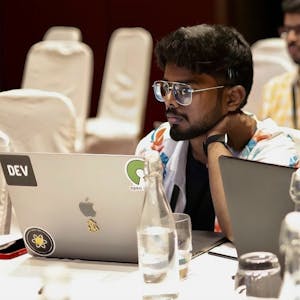SolidJS: Why All the Suspense?
28 min
SolidJS: Why All the Suspense?
Top ContentSolid caught the eye of the frontend community by re-popularizing reactive programming with its compelling use of Signals to render without re-renders. We've seen them adopted in the past year in everything from Preact to Angular. Signals offer a powerful set of primitives that ensure that your UI is in sync with your state independent of components. A universal language for the frontend user interface.
But what about Async? How do we manage to orchestrate data loading and mutation, server rendering, and streaming? Ryan Carniato, creator of SolidJS, takes a look at a different primitive. One that is often misunderstood but is as powerful in its use. Join him as he shows what all the Suspense is about.
But what about Async? How do we manage to orchestrate data loading and mutation, server rendering, and streaming? Ryan Carniato, creator of SolidJS, takes a look at a different primitive. One that is often misunderstood but is as powerful in its use. Join him as he shows what all the Suspense is about.
Modern Web Debugging
29 min
Modern Web Debugging
Top ContentFew developers enjoy debugging, and debugging can be complex for modern web apps because of the multiple frameworks, languages, and libraries used. But, developer tools have come a long way in making the process easier. In this talk, Jecelyn will dig into the modern state of debugging, improvements in DevTools, and how you can use them to reliably debug your apps.
When Optimizations Backfire
26 min
When Optimizations Backfire
Top ContentEver loaded a font from the Google Fonts CDN? Or added the loading=lazy attribute onto an image? These optimizations are recommended all over the web – but, sometimes, they make your app not faster but slower.
In this talk, Ivan will show when some common performance optimizations backfire – and what we need to do to avoid that.
In this talk, Ivan will show when some common performance optimizations backfire – and what we need to do to avoid that.
Angular Momentum
22 min
Angular Momentum
In this talk you'll learn all about the renaissance Angular has been going through! First, we'll look into how the framework embraced fine-grained reactivity with signals to boost its runtime performance by orders of magnitude.
After that we'll dive into applying a similar fine-grained approach to code loading to make everything load faster. At the end, you'll learn about the tooling you can leverage to land all this in your apps!
After that we'll dive into applying a similar fine-grained approach to code loading to make everything load faster. At the end, you'll learn about the tooling you can leverage to land all this in your apps!
Building a Web-App: The Easy Path and the Performant Path. Why Are They Not the Same?
31 min
Building a Web-App: The Easy Path and the Performant Path. Why Are They Not the Same?
We use frameworks to make building our applications easier. Yet as the application scales, its performance suffers. There is no one thing, but rather a death by thousand cuts. Developers are under pressure, and they often choose the easy and quick path to deliver a feature rather than the performant path. The performant path is usually more work. So let's look at these two paths and imagine a world where the performant path is the quick and easy path.
AI and Web Development: Hype or Reality
24 min
AI and Web Development: Hype or Reality
In this talk, we'll take a look at the growing intersection of AI and web development. There's a lot of buzz around the potential uses of AI in writing, understanding, and debugging code, and integrating it into our applications is becoming easier and more affordable. But there are also questions about the future of AI in app development, and whether it will make us more productive or take our jobs.
There's a lot of excitement, skepticism, and concern about the rise of AI in web development. We'll explore the real potential for AI in creating new web development frameworks, and separate fact from fiction.
So if you're interested in the future of web development and the role of AI in it, this talk is for you. Oh, and this talk abstract was written by AI after I gave it several of my unstructured thoughts.
There's a lot of excitement, skepticism, and concern about the rise of AI in web development. We'll explore the real potential for AI in creating new web development frameworks, and separate fact from fiction.
So if you're interested in the future of web development and the role of AI in it, this talk is for you. Oh, and this talk abstract was written by AI after I gave it several of my unstructured thoughts.
The State of Passwordless Auth on the Web
30 min
The State of Passwordless Auth on the Web
Can we get rid of passwords yet? They make for a poor user experience and users are notoriously bad with them. The advent of WebAuthn has brought a passwordless world closer, but where do we really stand?
In this talk we'll explore the current user experience of WebAuthn and the requirements a user has to fulfill for them to authenticate without a password. We'll also explore the fallbacks and safeguards we can use to make the password experience better and more secure. By the end of the session you'll have a vision for how authentication could look in the future and a blueprint for how to build the best auth experience today.
In this talk we'll explore the current user experience of WebAuthn and the requirements a user has to fulfill for them to authenticate without a password. We'll also explore the fallbacks and safeguards we can use to make the password experience better and more secure. By the end of the session you'll have a vision for how authentication could look in the future and a blueprint for how to build the best auth experience today.
ESM Loaders: Enhancing Module Loading in Node.js
22 min
ESM Loaders: Enhancing Module Loading in Node.js
Native ESM support for Node.js was a chance for the Node.js project to release official support for enhancing the module loading experience, to enable use cases such as on the fly transpilation, module stubbing, support for loading modules from HTTP, and monitoring.
While CommonJS has support for all this, it was never officially supported and was done by hacking into the Node.js runtime code. ESM has fixed all this. We will look at the architecture of ESM loading in Node.js, and discuss the loader API that supports enhancing it. We will also look into advanced features such as loader chaining and off thread execution.
While CommonJS has support for all this, it was never officially supported and was done by hacking into the Node.js runtime code. ESM has fixed all this. We will look at the architecture of ESM loading in Node.js, and discuss the loader API that supports enhancing it. We will also look into advanced features such as loader chaining and off thread execution.
DEADScript: The Role Of JavaScript In Web Sustainability
21 min
DEADScript: The Role Of JavaScript In Web Sustainability
In the web performance circles, we tend to closely watch paint times, blocking times, and so many more metric times, which all contribute to analyzing the user experience. In 2023, we have begun to pay more attention to metric tonnes. DEADScript is a presentation highlighting the resources we’re loading in modern development, and JavaScript’s unique role in this disquieting environmental dilemma.
Building a Voice-Enabled AI Assistant With Javascript
21 min
Building a Voice-Enabled AI Assistant With Javascript
Top ContentIn this talk, we'll build our own Jarvis using Web APIs and langchain. There will be live coding.
APIs are Evolving. Again.
28 min
APIs are Evolving. Again.
As developers we stand on the shoulders of giants, and it can be helpful to take a look at the past to gain a better perspective. In this talk we’ll briefly explore the past decade of backend development and architectural patterns.
We’ve often ditched technologies in an attempt to make the developer experience frictionless. However we sometimes forget what we can learn from “the good old days”.
What are you building: a monolith, a microservices system or something in between? A shift in how we see things can help us keep moving forwards.
We’ve often ditched technologies in an attempt to make the developer experience frictionless. However we sometimes forget what we can learn from “the good old days”.
What are you building: a monolith, a microservices system or something in between? A shift in how we see things can help us keep moving forwards.
Bun, Deno, Node.js? Recreating a JavaScript Runtime From Scratch
28 min
Bun, Deno, Node.js? Recreating a JavaScript Runtime From Scratch
Bun, Deno, and many other JavaScript runtimes have been hype, but do you know why? Is it that easy to make a runtime from scratch?
I've been researching the secret behind Node.js' power and why there are so many new JavaScript runtimes coming up. Breaking down each key component used on Node.js I've come to interesting conclusions that many people used to say whereas in practice it works a bit differently.
In this talk, attendees will learn the concepts used to create a new JavaScript runtime. They're going to go through an example of how to make a JavaScript runtime by following what's behind the scenes on the Node.js project using C++. They'll learn the relationship between Chrome's V8 and Libuv and what makes one JavaScript runtime better than others.
I've been researching the secret behind Node.js' power and why there are so many new JavaScript runtimes coming up. Breaking down each key component used on Node.js I've come to interesting conclusions that many people used to say whereas in practice it works a bit differently.
In this talk, attendees will learn the concepts used to create a new JavaScript runtime. They're going to go through an example of how to make a JavaScript runtime by following what's behind the scenes on the Node.js project using C++. They'll learn the relationship between Chrome's V8 and Libuv and what makes one JavaScript runtime better than others.
Top Core Web Vitals Recommendations for 2023
29 min
Top Core Web Vitals Recommendations for 2023
The Google Core Web Vitals team understand the amount of web performance recommendations is overwhelming and many don't know where to start. We've been working on identifying the 9 key recommendations (3 per Core Web Vital), which we think will have the most impact and which we recommend sites look at first. This talk will explain what they are, and why they are our top 2023 recommendations.
The Good, The Bad, and The Web Components
29 min
The Good, The Bad, and The Web Components
Top ContentThere has been no shortage of both fair and unfair criticism toward Web Components from a wide range of folks that build for the web, including but not limited to JavaScript Framework authors in supposed competition with the platform. In this talk I'll show you how to navigate and simplify the multifaceted landscape of web components, satisfying common criticisms and showing how you can Use the Platform most effectively today.
Apache Kafka Simply Explained With TypeScript Examples
27 min
Apache Kafka Simply Explained With TypeScript Examples
You’re curious about what Apache Kafka does and how it works, but between the terminology and explanations that seem to start at a complex level, it's been difficult to embark. This session is different. We'll talk about what Kafka is, what it does and how it works in simple terms with easy to understand and funny examples that you can share later at a dinner table with your family.
This session is for curious minds, who might have never worked with distributed streaming systems before, or are beginners to event streaming applications.
But let simplicity not deceive you - by the end of the session you’ll be equipped to create your own Apache Kafka event stream!
This session is for curious minds, who might have never worked with distributed streaming systems before, or are beginners to event streaming applications.
But let simplicity not deceive you - by the end of the session you’ll be equipped to create your own Apache Kafka event stream!
I Would Never Use an ORM
29 min
I Would Never Use an ORM
Top ContentWhat's an ORM? An Object-Relational Mapping tool (ORM) is a library to map a SQL table to a Class. In most cases, ORMs force the users to structure their code to have Model objects that include both data access and business logic.
Once upon a time, I did several projects using ORMs as I followed the common belief that they would simplify the development and maintenance of projects. I was wrong. ORMs are often a hurdle to overcome for the most complex part of a project.
As the next stop of my journey, I recommended people use the native languages of their databases, e.g., SQL. This works great for the most part, but it creates quite a struggle: there is a lot of boilerplate code to write that can be pretty tedious. I was wrong, again.
Today I'm presenting you Platformatic DB.
Once upon a time, I did several projects using ORMs as I followed the common belief that they would simplify the development and maintenance of projects. I was wrong. ORMs are often a hurdle to overcome for the most complex part of a project.
As the next stop of my journey, I recommended people use the native languages of their databases, e.g., SQL. This works great for the most part, but it creates quite a struggle: there is a lot of boilerplate code to write that can be pretty tedious. I was wrong, again.
Today I'm presenting you Platformatic DB.
Rome, a Modern Toolchain!
31 min
Rome, a Modern Toolchain!
Top ContentModern JavaScript projects come in many shapes: websites, web applications, desktop apps, mobile apps, and more. For most of them, the common denominator is the technical debt that comes from settings up tools: bundlers, testing suite, code analysis, documentation, etc. I want to present you Rome, a toolchain that aims to be a all-in-one toolchain for the web, with one single tool you can maintain the health of all your projects!
JavaScript Iteration Protocols
27 min
JavaScript Iteration Protocols
How many ways do you know to do iteration with JavaScript and Node.js? While, for loop, for...in, for..of, .map(), .forEach(), streams, iterators, etc! Yes, there are a lot of ways! But did you know that JavaScript has iteration protocols to standardise synchronous and even asynchronous iteration?
In this workshop we will learn about these protocols and discover how to build iterators and iterable objects, both synchronous and asynchronous. We will learn about some common use cases for these protocols, explore generators and async generators (great tools for iteration) and finally discuss some hot tips, common pitfalls, and some (more or less successful) wild ideas!
In this workshop we will learn about these protocols and discover how to build iterators and iterable objects, both synchronous and asynchronous. We will learn about some common use cases for these protocols, explore generators and async generators (great tools for iteration) and finally discuss some hot tips, common pitfalls, and some (more or less successful) wild ideas!
Dialog Dilemmas and Modal Mischief: A Deep Dive Into Pop-Ups
10 min
Dialog Dilemmas and Modal Mischief: A Deep Dive Into Pop-Ups
Our design systems commonly feature components that show on top of other content: tooltips, date pickers, menus and teaching UI, to name just a few. Proposed updates to the web platform are about to make building these a whole lot easier. You might not even need JavaScript. In this talk, you’ll learn all about the upcoming ‘popover’ attribute, modality and the top layer.
Bring AI-Based Search to Your Web App
31 min
Bring AI-Based Search to Your Web App
ChatGPT took the tech world by storm. Everyone talks about it, from your CTO to your hairdresser (at least my barber does). And there are many reasons why we should all be excited about it and many other AI/ML innovations.
But how do you bring them into your tech stack, your website/backend, to work with your data and provide AI-driven search and data augmentation?
There is a new generation of AI Native databases, which use deep learning models to find answers to natural language queries. We are talking about the ability to search through text, images, videos, DNA, or any unstructured data, all with a single query.
The rule of thumb: if there is an ML model, we can search through it.
Join me to learn about the foundation blocks (LLMs and vector embeddings, Vector Databases), how they all play together and most importantly - how you can build something yourself with open-source tech.
And, of course!!! There will be a live-coding demo, where I will take you through the experience of building an AI-based search – with Weaviate, an open-source Vector Database – and adding it to an app. Now the question... should this be done in Angular, React, Vue or just pure JS ;)
#MayTheDemoGodsBeWithUs
But how do you bring them into your tech stack, your website/backend, to work with your data and provide AI-driven search and data augmentation?
There is a new generation of AI Native databases, which use deep learning models to find answers to natural language queries. We are talking about the ability to search through text, images, videos, DNA, or any unstructured data, all with a single query.
The rule of thumb: if there is an ML model, we can search through it.
Join me to learn about the foundation blocks (LLMs and vector embeddings, Vector Databases), how they all play together and most importantly - how you can build something yourself with open-source tech.
And, of course!!! There will be a live-coding demo, where I will take you through the experience of building an AI-based search – with Weaviate, an open-source Vector Database – and adding it to an app. Now the question... should this be done in Angular, React, Vue or just pure JS ;)
#MayTheDemoGodsBeWithUs
Maintaining a Component Library at Scale
9 min
Maintaining a Component Library at Scale
This talk is about an example approach on how to organise maintenance across multiple teams, where we talk about how we came to this plan at Jumbo and what benefits it brings to the Developer Experience while being able to continuously deliver features to our customers.
We're dealing with maintenance, ownership, adding small features, upgrading from Vue2 to Vue3 and the culture that supports this way of working.
We're dealing with maintenance, ownership, adding small features, upgrading from Vue2 to Vue3 and the culture that supports this way of working.
Package-based Monorepos - Speed Up in Under 7 Minutes
9 min
Package-based Monorepos - Speed Up in Under 7 Minutes
They gave me just 7 minutes! So this is a no-slides, just code talk! I'm gonna show you a Yarn/NPM/PNPM workspaces-based monorepo implementation and how we can speed it up. In particular, I'm using Nx on top to get better parallelization, the ability to define task pipelines, caching, and more. Curious? Join me!
Accessible Component System Through Customization
30 min
Accessible Component System Through Customization
Most current UI libraries provide great user experience with a vast of components. But when it comes to heavy customization, and non-standard scenarios, especially for E-Commerce, they become hard to manage, scale or even slow down performance.
How to create a UI library that provides users the most possible freedom in customizing components, while keeping our performance and scalability to the fullest? How much accessible we can provide out of the box to our users? How much customization freedom is enough?
That's what my talk's about.
How to create a UI library that provides users the most possible freedom in customizing components, while keeping our performance and scalability to the fullest? How much accessible we can provide out of the box to our users? How much customization freedom is enough?
That's what my talk's about.
Create AR Face Filters With the Chrome Face Detection API
30 min
Create AR Face Filters With the Chrome Face Detection API
In the fast pacing space of social media apps, some functionality could also be used for web applications. I am going to show you how you could use the feature flagged Face Detection API in Chrome. With a demo, we will explore the possibilities to implement face filters in your future projects. With the webcam access of a device, we add glasses by processing a video feed and using it for fun, finding that sweet spot where fun and learning come together.
How I Like to Write JavaScript
26 min
How I Like to Write JavaScript
I love writing JavaScript. It feels lightweight, free-form, and flexible--all qualities that boost creativity and invite me to practice new and interesting techniques. Over time, I've developed lots of patterns and principles that help me day to day. In this talk, I'll show you a handful of them and then we'll look at how I apply them inside the AlpineJS codebase itself. It's gonna be a good time!
Comparing JavaScript Frameworks Performance Using Real-World Data
28 min
Comparing JavaScript Frameworks Performance Using Real-World Data
Google collects performance information from all sessions on opted-in Chrome browsers into its Chrome User Experience Report (CrUX) database. It then uses this information as a ranking factor for its search engine, but it also makes this information publicly available for everyone to view. I used this data to analyze and compare the performance of the leading JavaScript frameworks. In particular, I looked at the likelihood that websites built using each framework will have good Core Web Vitals (CWV) scores. Along the way I encountered several surprising results, and solved at least one mystery. See how your favorite framework ranks vs all the rest!
Three Ways to Automate Your Browser, and Why We Are Adding a Fourth: WebDriver BiDi
19 min
Three Ways to Automate Your Browser, and Why We Are Adding a Fourth: WebDriver BiDi
A journey through overwhelming ways to automate browsers. Join Michael on a journey to see what happens behind the scenes of "await page.goto('https://example.com');" et. al. See what pros and cons each of the three ways of browser automation have.
Understand why we are adding a fourth - WebDriver BiDi.
Understand why we are adding a fourth - WebDriver BiDi.
Progressive Enhancement - What It Is and Isn’t, a Practical Introduction With Svelte
21 min
Progressive Enhancement - What It Is and Isn’t, a Practical Introduction With Svelte
Progressive Enhancement is the philosophy of providing a basic, functional experience to everyone, regardless of device, and adding additional layers of interactivity and delight as they are supported. The last decade of web development, focusing on SPAs, where JavaScript is a hard requirement, have made this philosophy very difficult – how do we make websites that are fundamentally built with JavaScript accessible to users without it? This talk examines the philosophy behind Progressive Enhancement, then focuses on some concrete examples (including a dive into Svelte compiler output!) of how we can build functional, reliable, and usable experiences for all, adding delightful interactivity for those who can support it.
HTTP/3 Performance for JS Developers
21 min
HTTP/3 Performance for JS Developers
Top ContentHTTP/3 is the hot new networking protocol, available today! While you get most of its benefits out-of-the-box, there are also quite some things you can and should do to get maximise performance.
In this talk, we look at optimizing JS payloads for the first network round trips, how browsers prioritize JS against other resource types, SPA vs MPA nuances, and how to optimally use the 0-RTT and 103 Early Hints features. We also look at the protocol's integration with fetch() and talk about the upcoming WebTransport!
In this talk, we look at optimizing JS payloads for the first network round trips, how browsers prioritize JS against other resource types, SPA vs MPA nuances, and how to optimally use the 0-RTT and 103 Early Hints features. We also look at the protocol's integration with fetch() and talk about the upcoming WebTransport!
Mobile Deployments for Web Developers
23 min
Mobile Deployments for Web Developers
It's easier than ever to use JavaScript to build native mobile applications. But for web developers building in the mobile ecosystem for the first time, deploying cross-platform apps built with tools like Capacitor or React Native can be complex. Learn about the mobile-specific deployment considerations through the lens of a web developer, including the key differences between mobile and web, how to develop a deployment strategy, and how to evaluate tooling options.
What’s New in Node?
35 min
What’s New in Node?
This talk will walk you through some of the cool features in node that you might have missed.
Woah! Can TypeScript Do That?
41 min
Woah! Can TypeScript Do That?
These days, TypeScript is an industry default as it provides amazing DX with autocomplete, confident code refactoring and much more. But most developers only scratch the surface and doesn't use Typescript to its fullest potential.
This talk would dive into the powerful and advance concepts of TypeScript like generics, conditional types, type guard, utility types for type transformations and much more using real world examples to better understand these concepts.
This talk would dive into the powerful and advance concepts of TypeScript like generics, conditional types, type guard, utility types for type transformations and much more using real world examples to better understand these concepts.
5 Ways You Could Have Hacked Node.js
22 min
5 Ways You Could Have Hacked Node.js
Top ContentAll languages are or were vulnerable to some kind of threat. I’m part of the Node.js Security team and during the year 2022, we've performed many Security Releases and some of them were really hard to think about.
Did you know you can make money by finding critical vulnerabilities in Node.js? In this talk, I’ll show you 5 ways you can have hacked Node.js and how the Node.js team deals with vulnerabilities.
Did you know you can make money by finding critical vulnerabilities in Node.js? In this talk, I’ll show you 5 ways you can have hacked Node.js and how the Node.js team deals with vulnerabilities.
Maximum Efficiency: A Primer on Capacitor
12 min
Maximum Efficiency: A Primer on Capacitor
Quick, what is the quickest way to bring your product to the app stores? In today's landscape, trying to get into the app store can mean spending weeks deciding what tool to use and then rewriting your entire app. But the web, and mainly Capacitor, can simplify that. Take your existing web app, add Capacitor to the mix, and you have a native app that's ready for the stores! Let's see what's possible Capacitor and why it can help you ship faster.
Anyone Can Be an Open Source Maintainer
7 min
Anyone Can Be an Open Source Maintainer

Maintaining open source repos isn't just for "experts". Even junior developers can make great maintainers. Here's how I started maintaining a project and you can do it too.
Web Push Notifications Done Right
11 min
Web Push Notifications Done Right
Finally, Web Push API is available in all major browsers and platforms. It's a feature that can take your users' experience to the next level or... ruin it! In my session, after a tech intro about how Web Push works, we'll explore implementing smart permission request dialogues, various types of notifications themselves, and communicating with your app for more sophisticated scenarios - all done right, with the best possible UX.
Pushing the Limits of Video Encoding in Browsers With WebCodecs
25 min
Pushing the Limits of Video Encoding in Browsers With WebCodecs
Top ContentHigh quality video encoding in browsers have traditionally been slow, low-quality and did not allow much customisation. This is because browsers never had a native way to encode videos leveraging hardware acceleration. In this talk, I’ll be going over the secrets of creating high-quality videos in-browsers efficiently with the power of WebCodecs and WebAssembly. From video containers to muxing, audio and beyond, this talk will give you everything you need to render your videos in browsers today!
i18n Was the Missing Piece: Let 70%+ of the Users in the World to Access Your Apps
13 min
i18n Was the Missing Piece: Let 70%+ of the Users in the World to Access Your Apps
Accessibility, better DX, and performance get a lot of attention as it improves better UX significantly. Plus, it gives satisfaction to devs by seeing the significant improvements. But how about internationalization? A fun fact: Over 70% of the users in the world access non-English content. In this talk, I'll show you more surprising facts about internationalization and what are scalable approaches. You'll see examples with libraries for frameworks with a few different logic to implement different internationalization layouts.
Responsive Images for Your Website
7 min
Responsive Images for Your Website
Why bother to optimize images? Images often account for most of the downloaded bytes on a web page. As a result, optimizing images can frequently yield of the performance improvements for your website.
Static Analysis in JavaScript: What’s Easy and What’s Hard
23 min
Static Analysis in JavaScript: What’s Easy and What’s Hard
We are all using static analysis tools like ESLint every day to ensure the better quality of our code. How does it work, and what is tricky about JavaScript, making writing a proper rule often not trivial?
Building an IoT App With InfluxDB, JavaScript, and Plotly.js
20 min
Building an IoT App With InfluxDB, JavaScript, and Plotly.js
The Internet of Things (IoT) is increasingly driven by sensor data, with devices taking measured actions based on everything from wind speed and direction, vital body functions, illumination intensity, and temperature.
In this session we will showcase how to build a fully functional sample IoT monitoring application built with javascript and utilizing InfluxDB as its backend. With integrations to visualization libraries such as Plotly, creating automated alerts with InfluxDB as well as data downsampling.
In this session we will showcase how to build a fully functional sample IoT monitoring application built with javascript and utilizing InfluxDB as its backend. With integrations to visualization libraries such as Plotly, creating automated alerts with InfluxDB as well as data downsampling.
Start Building Your Own JavaScript Tools
22 min
Start Building Your Own JavaScript Tools
Your first JavaScript tool might not be the next Babel or ESLint, but it can be built on them! Let's demystify the secret art of JavaScript tools, how they work, and how to build our own. We'll discover the opportunities in our everyday work to apply these techniques, writing our own ESLint rules to prevent mistakes and code transforms to make breaking changes easy to apply. We’ll walk through the fundamentals of working with an abstract syntax tree, and develop our understanding through a live-code. You will be amazed at what you can build, and together we’ll explore how to get started.
The Future Stack of Code Review
22 min
The Future Stack of Code Review
Somehow, the code review had the same jokes and process while the software development world changed daily. Join us to learn how to adapt this process to the modern stacks and make the CR process an efficiency party.
Scaling Distributed Machine Learning, to the Edge & Back
21 min
Scaling Distributed Machine Learning, to the Edge & Back
This talk will cover why and how organizations are distributing data storage and machine learning to the edge. By pushing machine learning to the edge, we can geographically distribute learning so that the models will actually learn different things relevant to specific locations. By delivering both edge database and compute in a single platform, more people can transition to a distributed architecture. The performance gains from this new architecture cements the value that mobile edge computing brings.
What We Owe to Each Other
24 min
What We Owe to Each Other
Open source has won, and it's the center of gravity for our community. Whether we're contributors to open source projects, commercial product engineers, companies, developer advocates, or something else, we're all a part of this community. And we owe it to each other, and to ourselves, to leave the community better than we found it.
But how do we do that? What responsibilities do companies have to the community? Or developer advocates? Or OSS contributors? How are we failing those responsibilities, and how can we do better?
In short, what do we owe to each other? Let's find out.
But how do we do that? What responsibilities do companies have to the community? Or developer advocates? Or OSS contributors? How are we failing those responsibilities, and how can we do better?
In short, what do we owe to each other? Let's find out.
JavaScript Source Maps, Can We Do Better?
27 min
JavaScript Source Maps, Can We Do Better?
The current revision of the JavaScript Source Maps specification is over 12 years old. Throughout this time, the entire ecosystem has evolved immensely, but for some reason, we have done nothing to improve the debugging experience and are still stuck at version 3 of the specification. Can we do better?



























































